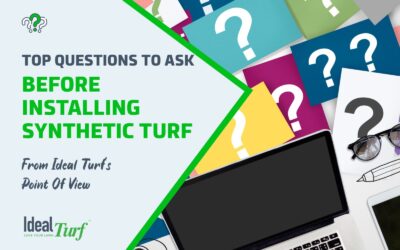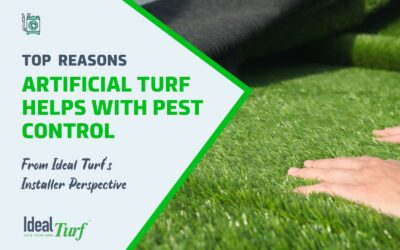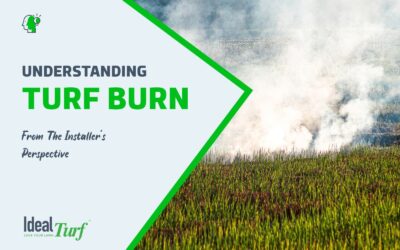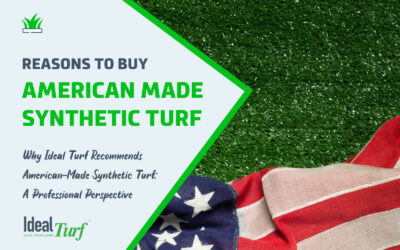Artificial Turf Cleaning Tips: How To Clean Artificial Grass to Keep it Looking Like Real Grass

What everyone loves about artificial turf is how low-maintenance it is compared to a natural lawn.
To ensure its longevity and to keep your artificial turf in tip-top shape scheduling regular cleaning and maintenance is essential.
However, the wrong artificial turf cleaning practices could damage your lush oasis.
We’re here to make sure that doesn’t happen.
Follow this complete guide on how to clean artificial turf to get the most out of your lovely landscape.

Introduction to Artificial Turf Maintenance
Unlike natural grass, artificial turf doesn’t require watering, mowing, or chemicals like fertilizers. A common misconception about artificial grass is that it’s ‘Zero Maintenance.’ That is not true. Artificial grass is ‘Low Maintenance’ NOT ‘Zero Maintenance.’
Regular cleaning and maintenance is important to maintain aesthetics, ensure proper drainage and extend its lifespan.
Over time, dirt, debris, and organic matter can accumulate, causing discoloration and odors. Cleaning usually involves sweeping, washing with water and mild detergent, and using specialized equipment if necessary. Preserve your artificial turf’s aesthetic appeal and ensure it lasts longer with these tools.
Tools & Supplies Needed for Turf Maintenance
Essential Tool List
- Brushes or rakes with soft bristles to fluff up the turf fibers and remove debris.
- Leaf blowers for quick removal of leaves and other lightweight debris.
- Hose for watering and rinsing.
- Mild detergent or specialized artificial turf cleaner for tougher stains.
Cleaning Solutions
- Natural cleaners like vinegar solution or mild soap and water.
- Commercial cleaners specifically designed for artificial turf, ensuring safe and effective cleaning without damaging the turf fibers.

Turf Cleaning & Maintenance Schedule
The frequency of cleaning your artificial turf will depend on a few things including surrounding trees and shrubbery, foot traffic, kids, pets, and local weather conditions. Generally, a regular cleaning schedule is recommended to prevent debris buildup and maintain the turf’s appearance and functionality. An at-home artificial turf maintenance schedule may look a bit like this:
Weekly/Bi-weekly Turf Cleaning Schedule
- Day: Saturday (Weekly)
- Time Required: 20-30 minutes
- Cleaning Routine:
- Sweep Debris: Use a broom or stiff brush to sweep away leaves, twigs, and other loose debris from the turf surface.
- Day: Wednesday (Bi-weekly)
- Time Required: 15-20 minutes
- Cleaning Routine:
- Spot Cleaning (As Needed):
- Inspect the turf for any stubborn stains or spots.
- Prepare a solution of mild detergent and water, if necessary.
- Apply the solution to the affected area and gently scrub with a brush.
- Rinse with Water:
- Use a hose with a spray nozzle to thoroughly rinse the turf surface, removing dirt and detergent residue.
- Spot Cleaning (As Needed):
Note: Adjust the schedule based on usage and weather conditions. Regular maintenance ensures a clean and attractive artificial turf surface.
Basic Turf Cleaning & Maintenance Tips
Implementing a simple weekly or bi-weekly cleaning routine can help keep your artificial turf in top condition. Here are some basic tips:
- Use a brush or rake to remove leaves, twigs, and other debris.
- Use a leaf blower for more efficient cleanup, especially in larger areas.
- Rinse the turf with water to remove dust and dirt, focusing on high-traffic areas.
Deep Cleaning & Maintenance Tips
In addition to regular upkeep, periodic deep cleaning is crucial to rejuvenate your synthetic grass and extend its lifespan. Consider the following:
- Perform a thorough cleaning every few months, depending on usage and environmental factors.
- Use a mild detergent or specialized artificial turf cleaner to remove stubborn stains.
- Consider replenishing the infill material to maintain turf resilience and appearance.

Step-By-Step Guide to Cleaning Artificial Turf
For a comprehensive cleaning process, follow these step-by-step instructions:
- Removing Debris: Start by manually removing leaves, twigs, and other debris using a brush, rake, or leaf blower.
- Spot Cleaning Stains: Treat common stains such as pet waste, food spills, and mildew with a suitable cleaner, following the manufacturer’s instructions.
- Washing the Turf: Use a hose or watering can to thoroughly rinse the turf, ensuring even coverage and effective removal of dirt and cleaning residues.
- Prevent Weeds: Regularly inspect the turf for signs of weed or moss growth, and promptly remove any unwanted vegetation using safe and non-toxic methods.
Special Considerations for Dog Owners
Pet owners should take extra care when cleaning artificial pet turf to manage pet-related messes regularly and effectively.
- Remove solid waste promptly and rinse the affected area with water.
- Use pet-safe cleaners to eliminate odors and disinfect the turf surface.
- Consider applying a pet-specific artificial turf deodorizer like OxyTurf to maintain freshness.
Seasonal Turf Maintenance Tips
Each season brings its own set of challenges for artificial turf maintenance. Consider the following seasonal tips:
Summer Turf Maintenance Tips:
- Mist with a hose to quickly lower surface temperature.
- Pick up leaves, sticks, twigs, etc.
- Rinse turf with hose to remove dust and pollen.
- Consider applying a UV protectant to minimize fading.
Winter Turf Maintenance Tips:
- Clear snow and ice promptly to prevent damage.
- Avoid using salt-based de-icing products.
- Don’t use metal shovels on turf.
Fall Turf Maintenance Tips:
- Regularly remove fallen leaves from the turf to prevent them from accumulating and blocking drainage.
- Check for any signs of wear, tear, or damage caused during the summer months, and repair as necessary to prevent further deterioration.
Spring Turf Maintenance Tips:
- Conduct a deep cleaning of the turf surface to remove any debris, dirt, or grime that may have accumulated over the winter.
- Check seams and edges for any signs of separation or lifting, and re-secure or repair them as needed to maintain a smooth surface.
- Brush, groom, and check for compaction.

Troubleshooting Common Problems
Maintaining artificial turf involves more than just routine care; it also requires troubleshooting common problems that can arise over time. Despite its durability, artificial turf is not immune to problems like flattening, drainage issues, and wear and tear. Flattened or matted turf can detract from its aesthetic appeal and functionality, while drainage problems can lead to water pooling and potential damage.
By being proactive and addressing these issues promptly, you can prolong the lifespan of your artificial turf and keep it looking and performing its best. Here are some troubleshooting tips for two common problems: flattened or matted turf, and drainage issues.
Flattened or Matted Turf
Reviving flattened or matted areas on artificial turf is essential for maintaining its appearance and functionality. Here’s how to do it effectively:
- Brushing or Raking: Use a stiff brush or rake designed for artificial turf to gently lift the flattened fibers. With a stiff bristle push broom, start at one side of your turf installation and walk across the turf against the grain of the fibers.
- Power Broom: For larger or stubborn areas, use a power broom with adjustable settings to agitate and lift the fibers without damaging the turf. Infill Redistribution: Ensure the infill is evenly distributed by gently working it into the fibers with a brush or rake.
- Watering: Lightly water the area to soften the fibers before brushing or raking, avoiding overwatering to prevent compaction.
- Regular Maintenance: Incorporate routine brushing or raking of high-traffic areas and avoid placing heavy objects on the turf to prevent future flattening.
Drainage Issues
Turf drainage issues in artificial turf, often caused by infill material blocking the drainage holes, can lead to water pooling and potential damage. Here’s how to fix them:
- Identify the Problem: Look for water pooling on the turf surface, indicating blocked drainage holes.
- Clear Obstructions: Use a stiff brush or rake to carefully remove infill material blocking the holes.
- Improve Drainage: Consider adding drainage gravel or installing a perforated pipe beneath the turf.
- Maintenance: Regularly inspect and clear drainage holes to prevent future issues.

DIY vs. Professional Turf Cleaning Services
Homeowners can manage routine cleaning, brushing, and minor repairs of their artificial turf themselves. However, tasks like infill replacement are best left to the pros. Signs for professional services include uneven surfaces or major damage. Professionals will replace infill, repair major damages, and perform specialized cleaning with specialized equipment and expertise, ensuring long-term turf performance.
When It’s Time To Call Us
- Infill Replacement: If the infill material has become compacted, contaminated, or insufficient, it may require professional replacement. Signs include uneven turf surface, poor drainage, or excessive wear in high-traffic areas.
- Major Repairs: Extensive damage such as large tears, significant seam separation, or widespread turf degradation may necessitate professional repair services.
- Specialized Cleaning: Stubborn stains, mold or mildew growth, or deep-seated dirt may require professional cleaning equipment and expertise.
What To Expect:
- Infill Replacement: A team of artificial turf professionals will assess the condition of the existing infill, remove it if necessary, and install new infill material to restore proper drainage and turf resilience.
- Major Repairs: Repair services may involve patching or replacing damaged sections of turf, rejoining seams, and ensuring the overall integrity of the installation.
- Specialized Cleaning: Skilled cleaners may use specialized equipment such as power washers or turf-specific cleaning solutions to deep-clean and sanitize the turf surface, addressing stubborn stains and microbial growth.

Wrapping Up: Artificial Turf Cleaning Tips
Consider these tips as you embark on your journey to a beautiful and hassle-free outdoor space.
OR leave it to the professionals.
Ideal Turf recently launched our “Turf Refresh” program to offer maintenance, repair, cleaning, and odor removal services.
For installation, maintenance, and more simply click the “GET A QUOTE” button or call our team at (806) 556-6012.
Recent Posts
- How Synthetic Turf Helps Keep Fleas and Ticks Out of Your Texas and Oklahoma Yard
- Porches, Patios & Personality: Creating Outdoor Spaces Texans Love
- Turn Your Backyard into a Golfer’s Dream: Custom Putting Greens by Ideal Turf
- Why Texas Pet Owners Are Choosing Pet-Friendly Artificial Grass from Ideal Turf
- Why More Texans and Oklahomans Are Turning to Artificial Grass for a Greener Future






